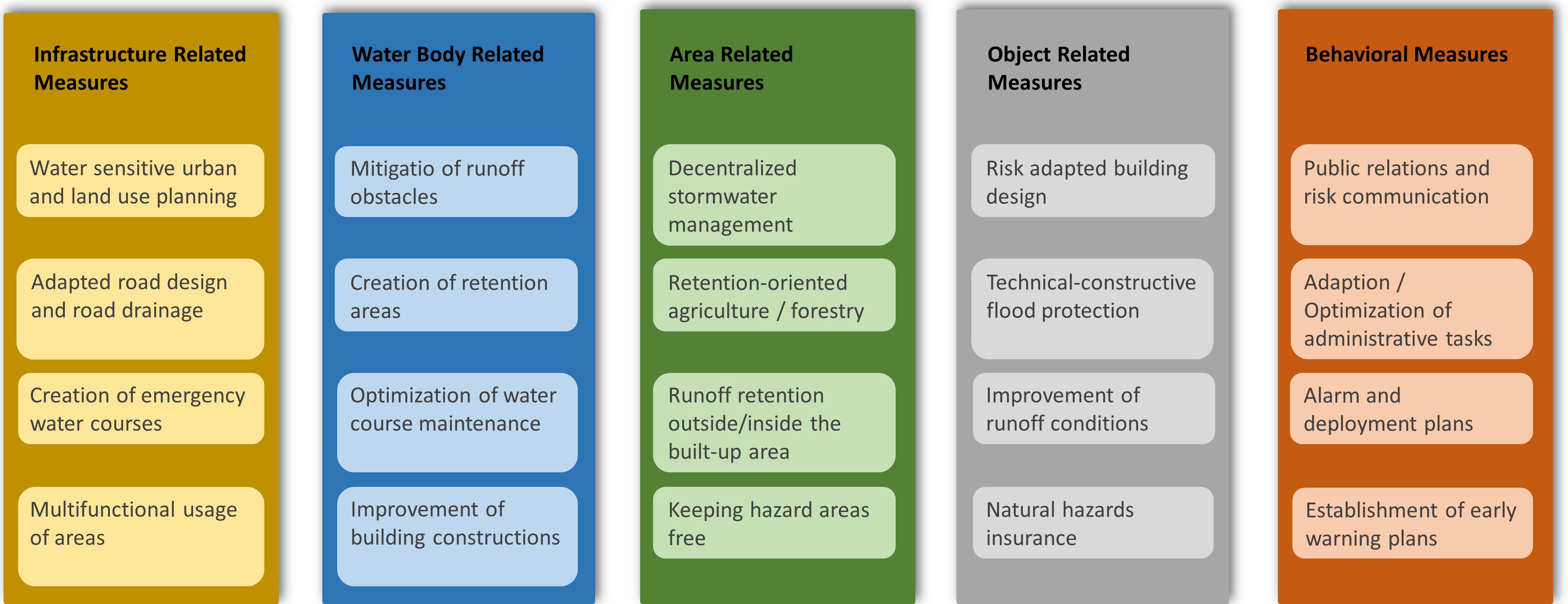Fundamentals of Adaptation to Climate Change
What does adaptation to climate change mean?
In the political-economic debate, the IPCC definition has prevailed and is defined as follows:
In the political-economic debate, the IPCC definition has prevailed and is defined as follows:
"The process of adjusting to actual or expected climate and its impacts. In human systems, adaptation is directed at reducing or avoiding harm, or taking advantage of beneficial opportunities. In some natural systems, adaptation to the expected climate and its impacts may be enabled by human intervention." (IPCC, 2014)
"Basically, a distinction is made between autonomous (spontaneous) and planned adaptation. Autonomous adaptation is adaptation that is not a conscious response to climatic stimuli, but is triggered by ecological changes in natural systems or changes in human systems. In contrast, planned adaptation is the result of a conscious policy decision based on an awareness that conditions have changed and action is needed to return to the former state, or to maintain or achieve a desired state (IPCC 2007)." (GERICS)
"Adjustment is an iterative process of (a) defining the problem, (b) planning and implementing actions, and (c) monitoring and reviewing implemented actions in light of new or changing information, risks, or regulations. Adjustment to new conditions may be ordered based on planning, or it may occur without policy guidance (www.climate-adaptation.info)." (GERICS)
Three key aspects of adaptation emerge from the IPCC (2014) definition:
- Adaptation to what?
- Who or what is responsible for carrying out adaptation?
- How is adaptation carried out?
Who or what is responsible for the implementation of adaptation?
For this purpose, the Federal Environment Agency (UBA) provides a brief overview of the main social actors.
Adaptation strategies and measures range from short-term coping approaches to long-term and far-reaching changes (MOSER & EKSTROM 2010). It is important to identify possible synergies or conflicts that may arise from a measure in terms of its influence on both climate change mitigation and adaptation (MOSER 2012).
This figure presents the basic strategies for adapting to the consequences of climate change, here for the coastal zone assuming rising sea levels. The same strategies are applicable in an adapted form to other water management systems.
As diverse as the effects of climate change on our environment, society and ourselves are, as diverse are measures for adaptation to the following climate changes. A categorization based on different levels of implementation, responsibilities, technical criteria, etc. will be made. In the following, the categorization of adaptation measures of the DWA (Deutsche Vereinigung für Wasserwirtschaft, Abwasser und Abfall e.V.) as well as the UBA (Federal Environment Agency) are presented as examples. In addition, a categorization deviating from the DWA and the UBA is shown.

The categorization here is based on the "location" of the measures through which they develop their effect.
The Federal Environment Agency categorizes measures from a constructional-technical point of view. Measures are categorized here as follows:
The Federal Environment Agency categorizes measures from a constructional-technical point of view. Measures are categorized here as follows:
- “Green" measures - e.g., gardens, parks, green roofs or facades, management of contiguous green and open spaces. These can allow water to infiltrate during heavy rain events, for example, reducing surface runoff.
- “Blue" measures - e.g., creation of flood retention basins, renaturalization of streams, or creation of retention areas to mitigate flood events.
- "Gray" measures - e.g., technical infrastructure and construction measures (dikes, flood-adapted construction, walls, etc.).
- "soft" measures - creating incentives for adaptation among stakeholders, e.g., through information, discounted insurance, modified levies, or specifications in planning.
Own example of categorization of climate adaptation measures:
- Types
- Structural <=> Non-structural
- Technical <=> Non-technical
- Conventionell <=> Nature-based
- Location
- Near source <=> Near estuary
- In the water body <=> In the catchment
- Location of effect
- Upstream <=> Downstream
- Effectivness
- Counteracts one problem <=> Counteracts several problems
- Effective in the short term <=>Effective in the long term
- Effective for moderate events <=> Effective for extreme events
References
- Abram, N., Gattuso, J.-P., Prakash, L., Cheng, M.P., Chidichimo, S., Crate, H., Enomoto, M., Garschagen, N., Gruber, S., Harper, S., Holland, E., Kudela, R.M., Rice, J., Steffen, K., von Schuckmann, K., 2019: Framing an dContext aof the Report, In: IPCC Special Report on the Ocean and Cryosphere in an Changing Climate [Pörtner, H.-O., Roberst, D.C., Masson-Delmotte, V.; Zhai, P., Tignor, M., Poloczanka, E., Mintenbeck, K., Alegria, A., Nicolai, M., Okem, A., Petzold, J., Rama,
- DWA Deutsche Vereinigung für Wasserwirtschaft, Abwasser und Abfall e.V. (Hrsg.): Risikomanagement in der kommunalem Überflutungsvorsorge für Entwässerungssysteme bei Starkregen, DWA-Regelwerk, Merkblatt DWA-M 119, Ausgabe 11/2016, DWA, 2016
- Oppenheimer, M.; Glavovic, B.C.; Hinkel, J.; van de Wal, R.; Magnan, A.K.; Abd-Elgawad, A.; Cai, R.; Cifuentes-Jara, M.; DeConto, R.M.; Ghosh, T.; Hay, J.; Isla, F.; Marzeion, B.; Meyssignac, B; und Sebesvari, Z.: Sea Level Rise and Implications for Low-Lying Islands, Coasts and Communities. In: IPCC Special Report on the Ocean and Cryosphere in a Changing Climate [Pörtner, H.-O.; Roberts, D.C.; Masson-Delmotte, V.; Zhai, P.; Tignor, M.; Poloczanska, E.; Mintenbeck, K.; Alegría, A.; Nicolai, M.; Okem, A.; Petzold, J.; Rama, B.; Weyers, N.M. (eds)], In Press, 2019